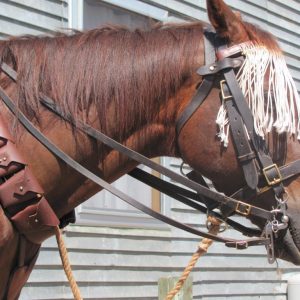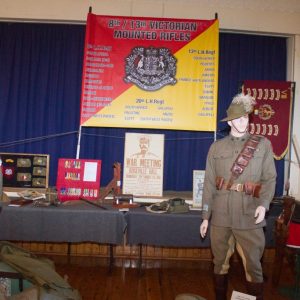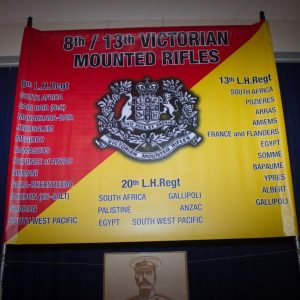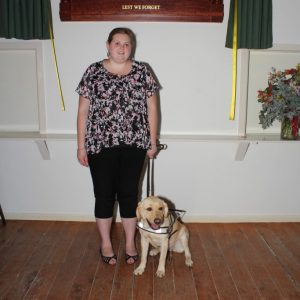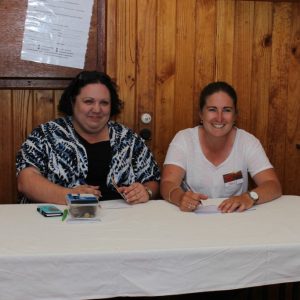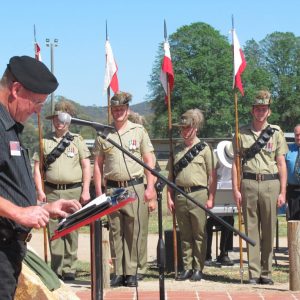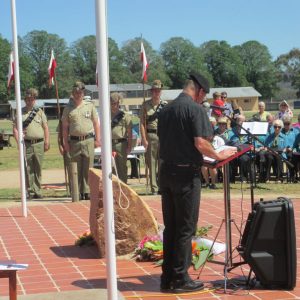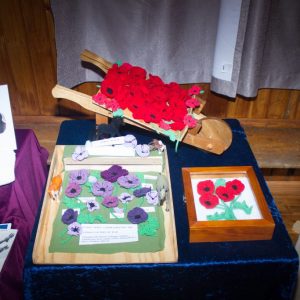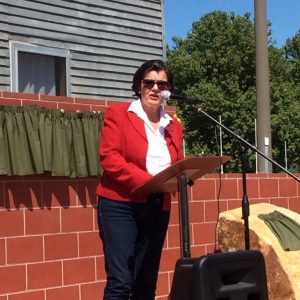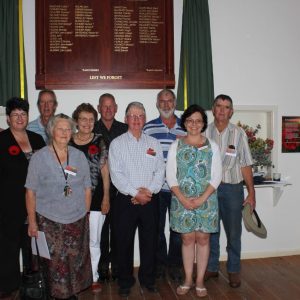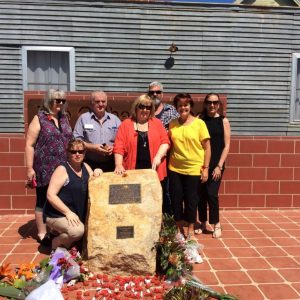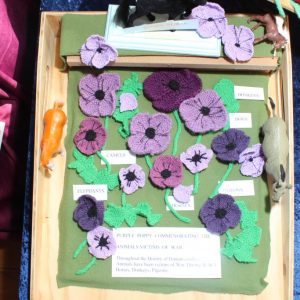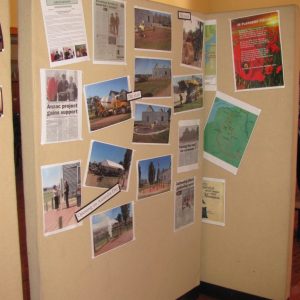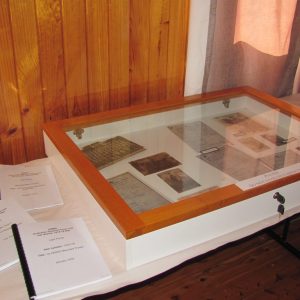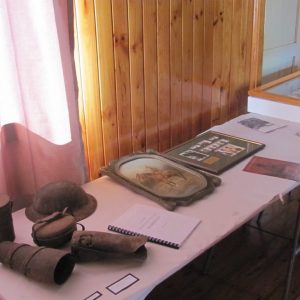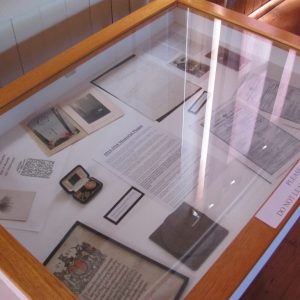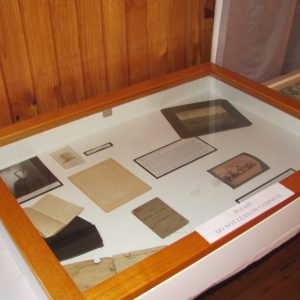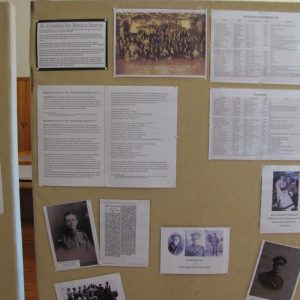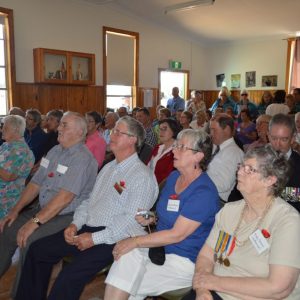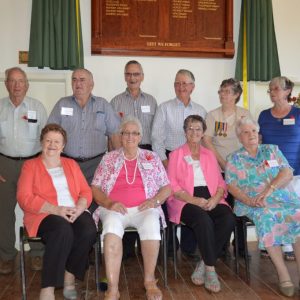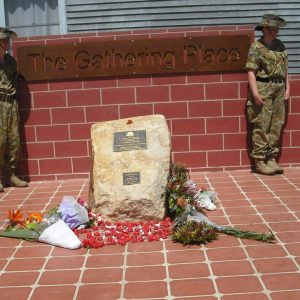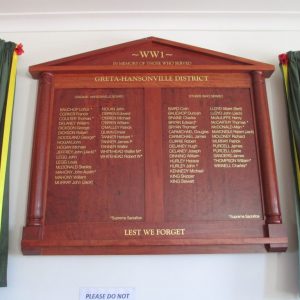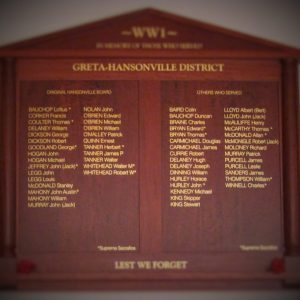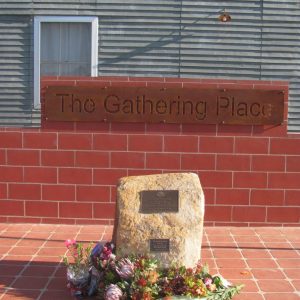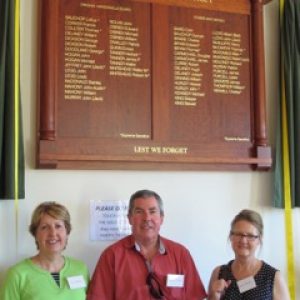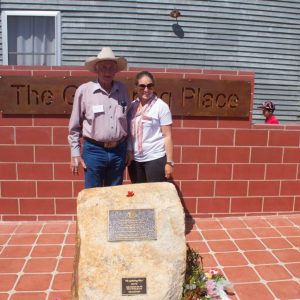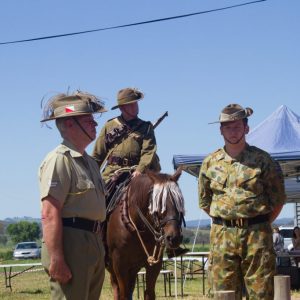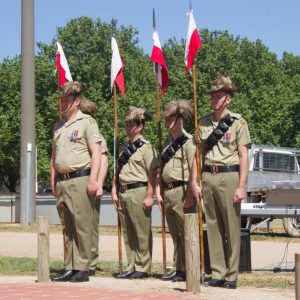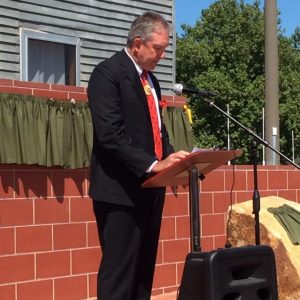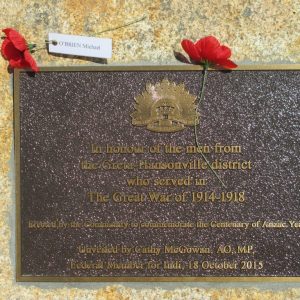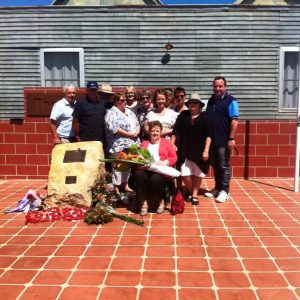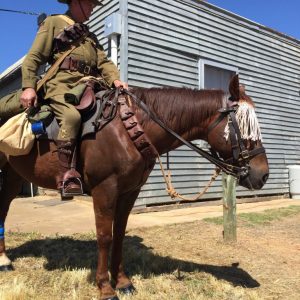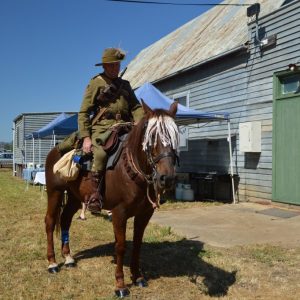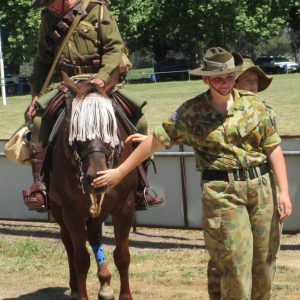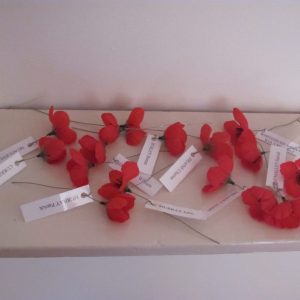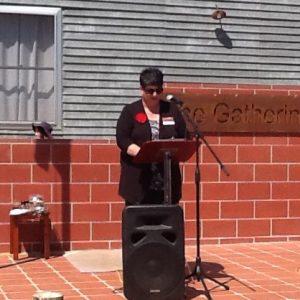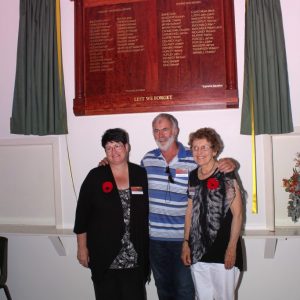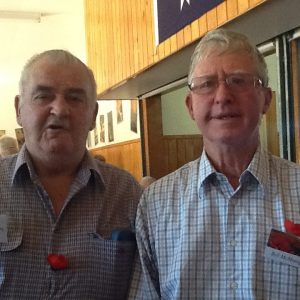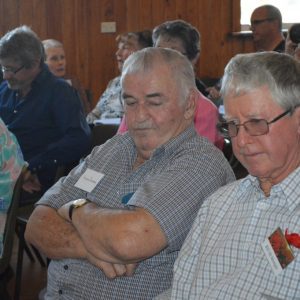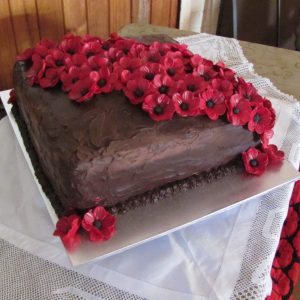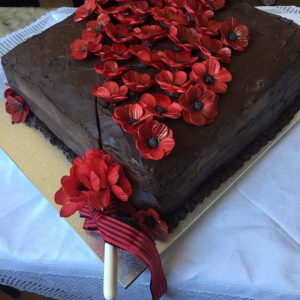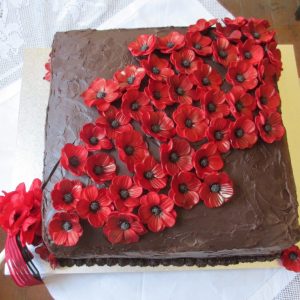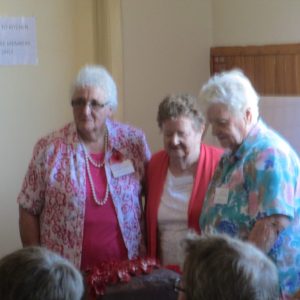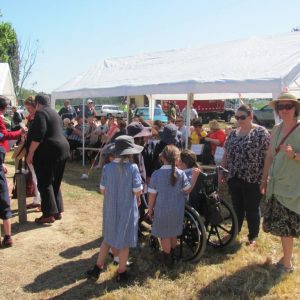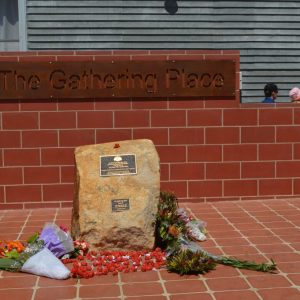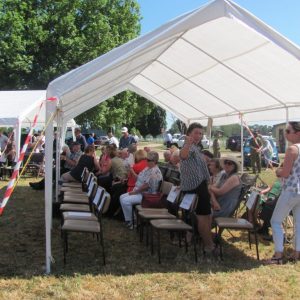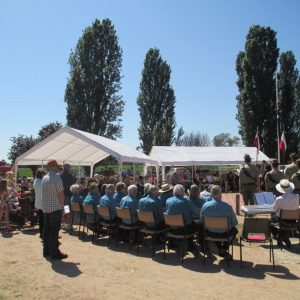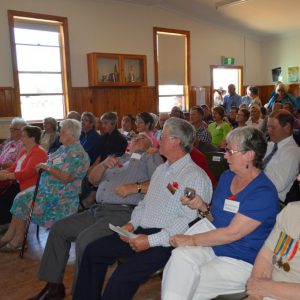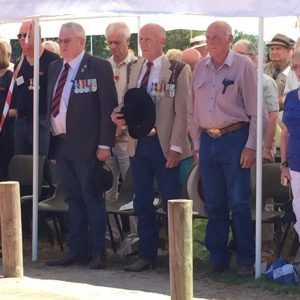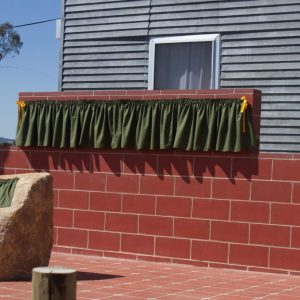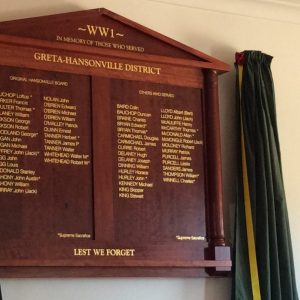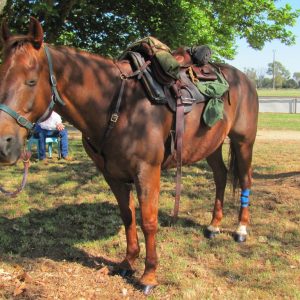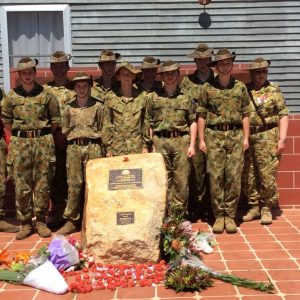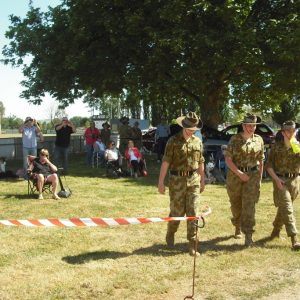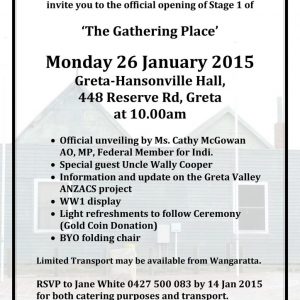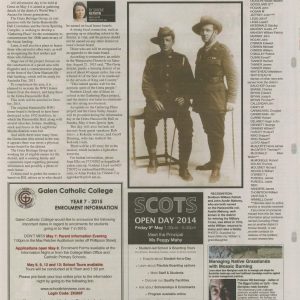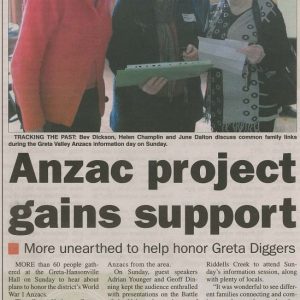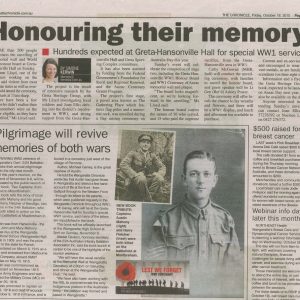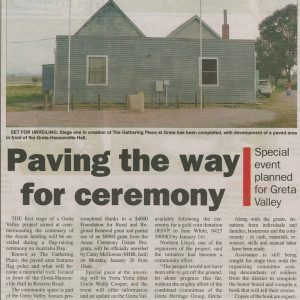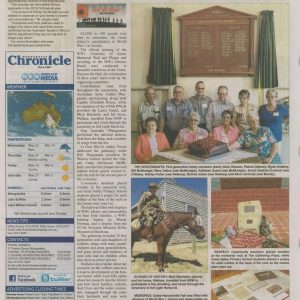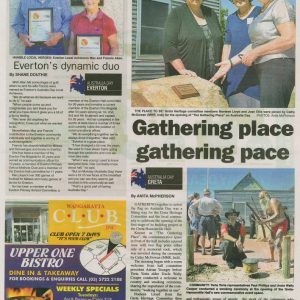The Official Opening of the World War One Centenary of Anzac Memorial Wall and Plaque, along with the unveiling of the World War One Honour Board took place at the Greta Hansonville Hall on 18 October 2015. This day was chosen as it was closest to the anniversary date of a farewell picnic held for a large group of twenty one recruits. Almost three hundred people gathered at Hansonville to say ‘hail and farewell\’.
The re-creation of the Greta-Hansonville Honour Boards and the Memorial Wall and Plaque evolved as a project of the Greta Heritage Group. This group originated with three individuals who shared a common interest in local history. In 2011, the Rural City of Wangaratta called for volunteers to be ‘Community Champions’ within their local districts. Noeleen Lloyd, Joan Ellis and Allan Porker accepted the role for the Heritage portfolio for Greta – and the Greta Heritage Group was born.
The first meetings were held around Joan and Ken Ellis’ kitchen table. Initially conversation centred on what was important to and for the district in terms of its rich and varied history and heritage. An information day was held – with the aim of getting locals to come along and share their stories; as well as allowing the group to understand what collections and resources were held by local families. The day provided an opportunity for residents to suggest what they thought was important and would like to see in the future.
The question of what had happened to the districts’ Honour Boards and Rolls was raised. There had been one in the Hansonville Hall but it was lost in the 1952 bushfire. There were also Honour Boards in the Hansonville School, Greta West School, and the Greta Methodist Church. The Greta School also had a list of twenty-four names. Despite an extensive search the Honour Boards and list have not been located.
Discussion turned to re-creating the Honour Boards and holding a memorial service for the upcoming ANZAC Centenary. However, the district did not have a flagpole to raise the Australian and Indigenous flags, nor a commemorative place to gather on any significant occasion. It seemed logical that any Honour Boards should hang at the Greta-Hansonville Hall, as the local halls had been the traditional gathering place for the community for more than a hundred years. The project began to take on a life of its own.
The proposed project would include the re-creation of the Honour Boards, a paved area with two flagpoles, a rock with a plaque and a memorial wall to honour those who served in all theatres of war. This small group had big dreams, enthusiasm – but no money! Working with both the Hall and the Sporting Complex, the group made an application for funding through the Foundation for Rural and Regional Renewal and to everyone’s astonishment, it was successful.
When the Anzac Centenary Local Grants Program was announced more days and nights were spent writing and researching. By this stage there was greater community interest and support and the group was thrilled to be successful. Working with representatives of the Greta Heritage Group, the Greta-Hansonville Hall and the Greta Sporting Complex, meetings were held monthly at the hall between December 2013 and October 2015. The combined committee was dedicated, enthusiastic and supportive, made up of long term and newer residents. The first part of the project was unveiled on Australia Day 2015, meeting the initial target.
The vision was to create something that the Greta-Hansonville district could be proud of and serve many generations to come. Fifty-six men were identified from the research conducted by Noeleen Lloyd that needed to have their names on the new Honour Board. Twenty-seven from the lost Hansonville Honour Board, and a further twenty-nine from countless hours of archival research.
Almost three hundred people attend what was a formal and Ceremonial occasion. Guests included descendants and families of the men named on the Honour Board, including ten first generation sons and daughters of soldiers, as well as large numbers of grandchildren and great grandchildren. The men who had no children or who died on active service were represented by great nieces and nephews.
The day started outside with a formal Ceremony to unveil the memorial plaque and wall. A number of Australian Army Cadets (Wangaratta) who along with Captain (AAC) Elizabeth Rouse participated in the day. Six members of the 4/19th Prince of Wales Light Horse provided the Lance Guard and Mick Batchelor and his horse, Wallace, travelled from NSW to participate. Mick and Wallace were in full Light Horse kit, and stood through the Ceremony. Sing Australia (Wangaratta) sang the National Anthem, God Save the King, as well as a number of songs from the era. Lt. Col. (ret) Ash Power gave the key note address followed by Dr Warren Garrett, Wangaratta RSL President, who recited the Ode. Marcel Tonini played The Last Post and Reveille.
Wreaths were placed at the memorial rock by community members and Greta Valley Primary School students placed a poppy for each soldier at the base of the rock as the names were read out. Former Member for Indi, Cathy McGowan, unveiled the Centenary of Anzac memorial plaque and wall outside before guests moved inside the Hall for the second part of the Ceremony.
The Hall was filled with displays of World War One photos and memorabilia on loan from families, a World War One knitting display by Wendy Norman and a display from the 8/13th Victorian Mounted Rifles Museum at Bandiana. Noeleen Lloyd spoke about her research on the soldiers and how it lead to the Honour Board. Joan Ellis spoke about her research into the district and how local families, schools, Red Cross and wider community managed through the years their husbands and sons were away at war.
Mr Bill McMonigle and Mr Patrick Delaney were then invited to unveil the Honour Board in memory of their fathers’ and all the men of the district. Both are first generation sons of Anzacs and both their fathers were away from home for more than four and three years respectively. Mrs Shirley Fisher (Delaney), Mrs Noeline Croxford (O’Brien) and Mrs Alice Carmody (Murray) cut the Remembrance Cake, which was to honour the women, children and the district who were left behind. It was a decadent triple layer cake with fifty-six handcrafted sugar poppies to represent the fifty-six names on the Honour Board (the families took these poppies home). Mr McMonigle later responded on behalf of the families thanking the Committee for their hard work and providing some insight into his father’s life post war.
Some families travelled large distances to be part of the day to reconnect with the district their father/grandfather lived in. There were also families present who had never been to the district and others who had not been there since childhood (more than sixty years). A large number of families took the opportunity to stay in the district visiting old family properties the Cemetery, churches and in one case the old Hansonville Store.
There were many families visiting places that they had never seen, or had only ever heard stories about; families who had not been in the area for many years also took the opportunity to revisit past memories. Stories were shared; new connections made and old ones re-established. One guest, whose Grandfather is named on the Honour Board told Noeleen that her letter to him arrived the day his father died, he has now gained a sense of connectedness to the district although he never lived here.
Images: Courtesy of Noeleen Lloyd, Helen Champlin, and Brendan French

![The Gathering Place Opening [18 October 2015] The Gathering Place Opening [18 October 2015]](http://www.gretaheritagegroup.com.au/wp-content/uploads/2019/07/Gathering-Place-Banner-01.jpg)
